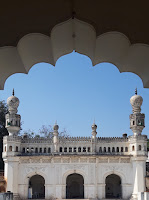A Song of Desolation- The Paigah Tombs of Hyderabad
Hyderabad surely is a city of many charms and not many people outside know about the rich heritage of this city has to offer. Beyond the scrumptious Dum Biryanis and kebabs, the historic Char Minar or the Golconda Fort, Hyderabad has a lot more to offer. For a person coming here for the first time, its streets and alleys present a unique medley of a past which is never too distant and a present which makes one feel nostalgic. Such is the heritage of this city where one can enjoy a plate of Biryani while sitting in a shop and wondering about its history and to some extent, even experiencing it.
In one such locality of the old town, amidst a maze of buildings and collapsing structures of a bygone time- but very much alive with the sounds of kids playing, goats bleating, chickens clucking, loud horns of bicycles and cars and people going about their businesses- rest the tombs of the Paigah nobles. Paigahs were one of the most powerful and influential families of the princely state of Hyderabad. They were the only noble family to have been granted the permission to keep a private army. They also regularly married the daughters of the Nizam or the members of the royal family. Fiercely loyal to the Nizamate, their tombs stand as a testimony to the glorious legacy of one of the most influential families in the city’s history.
However, amidst all the day to day hustle-bustle and ‘life’ that surrounds the tomb complex, both the memory and the path leading to it become obscure for a present-day traveller. However, the hard work and efforts that go into finding it totally pay off. For once a person enters through the narrow gate into the complex, one enters a wholly different dimension of idyllic silence. One where the walls etched with the most sublime of all poetry, tell their stories to the melodious rhythms of time. However, one does not merely see the poetry while walking through the galleries, one feels it deep within. Such is the riveting effect of the intricately carved marble and stucco architecture of these tombs.
Just one cursory glance and for a moment it seems that one has been transported back to Rajasthan or maybe the Taj Mahal. But upon closer inspection, one finds that the architecture is indeed very much Hyderabadi. Such a blend of different architectural styles is nowhere else to be found. The tombs make heavy use of geometric patterns and floral designs, some of which are so delicately carved on the walls that for a moment it feels like they have been cut on paper and not in plaster. And what’s more, is that each tomb has a unique design. Wooden gates with exquisite latticework set in a richly carved hooded canopy of multiple arches lead one inside a long series of interconnected rooms separated by equally magnificent walls of perforated screens or jali which let the light and air to pass through. This along with the multifoil arches, with small floral designs, give a unique sense of subtle movement to the entire structure. At some distance from the tombs is located a mosque with the classical Hyderabadi flat roof and minarets with small dome finials. Small trefoil merlons and a parapet with rich arabesque designs and highly ornamental facades add to the richness and beauty of the tomb complex.
However, this heart-warming poetry of the Paigah Tombs is also a song of desolation. Located in a heavily populated locality, the tombs are hardly visible and get very few visitors. While the coexistence of the past and the present in a single physical space or landscape may appease a romanticist’s idyllic imagination. However, from the point of view of heritage conservation, this cohabitation or encroachment, population pressure and resulting issues of pollution in the immediate environs of the monument are extremely detrimental for both its fabric and structure. Owing to the relative negligence of the authorities, several spaces within the complex have fallen in a state of ruin and wilderness, black mould can be seen on the plaster and walls eating them away, while pigeons can be found making comfortable nests in the commodious canopies of doors and recessions in the walls. This poetry of desolation has now become a living reality of many old structures in Hyderabad. For a city endowed with rich architectural heritage and growing population, it becomes all the more important for authorities to actively undertake the task of heritage conservation and preservation along with sensitising the people about the same. Songs of desolation, as idyllic and poetical they may seem right now, won't last with us forever and that would be a true loss indeed.













Very well written, Alina! Am longing to visit this structure someday,maybe!!
ReplyDeleteHehe Thank you so much Diptarka!
DeleteAmazing Alina👌👌👌👌
ReplyDeleteWhat rightly chosen words .... it's wonderful and you never fail to amaze me . :*
ReplyDeleteThank you so much :')
DeleteWell written Article !!
ReplyDeleteVery insightful and well written blog! Great work Alina.
ReplyDeleteThank you so much!
DeleteThis comment has been removed by the author.
ReplyDeleteA very well written blog Alina!! Great job💫
ReplyDeletehehe thanks :')
DeleteSuch an amazing blog! I loved it! I am so excited for a visit to this site! 😍
ReplyDeleteHaha, yes its totally worth visiting. Thanks a lot!
Delete